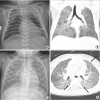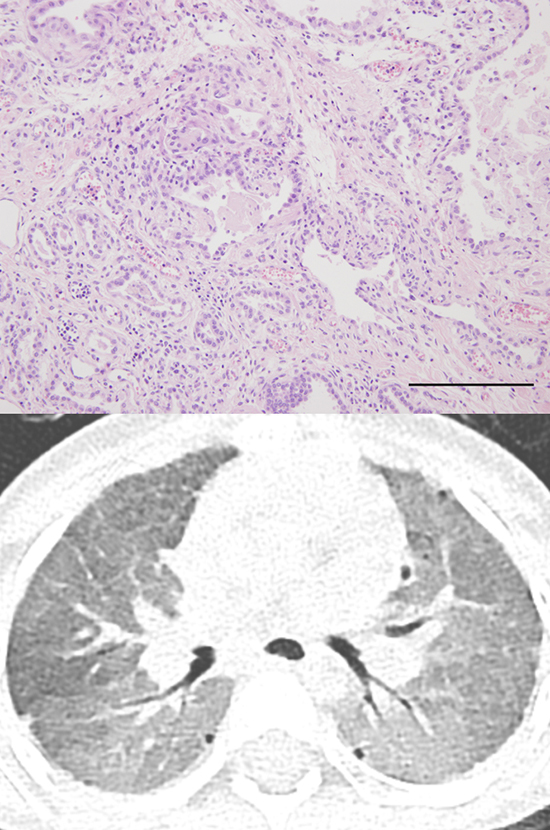1. Hawgood S. Pulmonary surfactant apoproteins: a review of protein and genomic structure. Am J Physiol. 1989; 257(2 Pt 1):L13–L22.

2. Weaver TE, Johnson Conkright J. Functions of surfactant proteins B and C. Annu Rev Physiol. 2001; 63(1):555–578.
3. Beers MF, Mulugeta S. Surfactant protein C biosynthesis and its emerging role in conformational lung disease. Annu Rev Physiol. 2005; 67(1):663–696.

4. Nogee LM, Dunbar AE, Wert SE, Askin F, Hamvas A, Whitsett JA. A mutation in the surfactant protein C gene associated with familial interstitial lung disease. N Engl J Med. 2001; 344(8):573–579.

5. Brasch F, Griese M, Tredano M, Johnen G, Ochs M, Rieger C, et al. Interstitial lung disease in a baby with a de novo mutation on the SFTPC gene. Eur Respir J. 2004; 24(1):30–39.
6. Lawson WE, Grant SW, Ambrosini V, Womble KE, Dawson EP, Lane KB, et al. Genetic mutations in surfactant protein C are a rare cause of sporadic cases of IPF. Thorax. 2004; 59(11):977–980.

7. Bullard JE, Wert SE, Nogee LM.
ABCA3 deficiency: neonatal respiratory failure and interstitial lung disease. Semin Perinatol. 2006; 30(6):327–334.
8. Goldfarb SB, Levvey BJ, Cherikh WS, Chambers DC, Khush K, Kucheryavaya AY, et al. Registry of the International Society for Heart and Lung Transplantation: twentieth pediatric lung and heart-lung transplantation report—2017; Focus Theme: allograft ischemic time. J Heart Lung Transplant. 2017; 36(10):1070–1079.

9. Stevens PA, Pettenazzo A, Brasch F, Mulugeta S, Baritussio A, Ochs M, et al. Nonspecific interstitial pneumonia, alveolar proteinosis, and abnormal proprotein trafficking resulting from a spontaneous mutation in the surfactant protein C gene. Pediatr Res. 2005; 57(1):89–98.

10. Thouvenin G, Taam RA, Flamein F, Guillot L, Le Bourgeois M, Reix P, et al. Characteristics of disorders associated with genetic mutations of surfactant protein C. Arch Dis Child. 2010; 95(6):449–454.

11. Salerno T, Peca D, Menchini L, Schiavino A, Boldrini R, Esposito F, et al. Surfactant protein C-associated interstitial lung disease; three different phenotypes of the same
SFTPC mutation. Ital J Pediatr. 2016; 42(1):23.

12. Kurland G, Deterding RR, Hagood JS, Young LR, Brody AS, Castile RG, et al. An official American Thoracic Society clinical practice guideline: Classification, evaluation, and management of childhood interstitial lung disease in infancy. Am J Respir Crit Care Med. 2013; 188(3):376–394.

13. Rosen DM, Waltz DA. Hydroxychloroquine and surfactant protein C deficiency. N Engl J Med. 2005; 352(2):207–208.

14. Arıkan-Ayyıldız Z, Caglayan-Sozmen S, Isık S, Deterding R, Dishop MK, Couderc R, et al. Survival of an infant with homozygous surfactant protein C (SFTPC) mutation. Pediatr Pulmonol. 2014; 49(3):E112–E115.
15. Beers MF, Chem JB. Inhibition of cellular processing of surfactant protein C by drugs affecting intracellular pH gradients. J Biol Chem. 1996; 271(24):14361–14370.

16. Litao MK, Hayes D Jr, Chiwane S, Nogee LM, Kurland G, Guglani L. A novel surfactant protein C gene mutation associated with progressive respiratory failure in infancy. Pediatr Pulmonol. 2017; 52(1):57–68.

17. Peca D, Boldrini R, Johannson J, Shieh JT, Citti A, Petrini S, et al. Clinical and ultrastructural spectrum of diffuse lung disease associated with surfactant protein C mutations. Eur J Hum Genet. 2015; 23(8):1033–1041.

18. Jhang WK, Park SJ, Lee E, Yang SI, Hong SJ, Seo JH, et al. The first successful heart-lung transplant in a Korean child with humidifier disinfectant-associated interstitial lung disease. J Korean Med Sci. 2016; 31(5):817–821.

19. Liu T, Sano K, Ogiwara N, Kobayashi N. A novel surfactant protein C L55F mutation associated with interstitial lung disease alters subcellular localization of proSP-C in A549 cells. Pediatr Res. 2016; 79(1-1):27–33.

20. Gupta A, Zheng SL. Genetic disorders of surfactant protein dysfunction: when to consider and how to investigate. Arch Dis Child. 2017; 102(1):84–90.







 PDF
PDF Citation
Citation Print
Print




 XML Download
XML Download